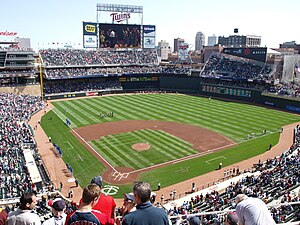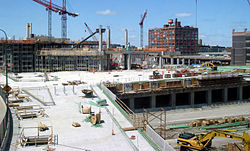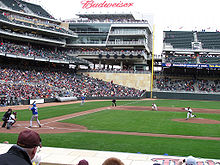Target Field
Source: Minnesota Legislative Reference Library[16] Immediately following Pohlad's 1994 declaration of intent, the Twins began making plans to build a new, retractable-roof stadium on a site just north of the Metrodome.
At that time, the desired site was largely underused as surface parking, despite being adjacent to the Mississippi River, and located in the city's historic milling district.
In advance of the session, Pohlad announced he had signed a letter of intent to sell the team to a potential ownership group in North Carolina (Piedmont Triad) led by Don Beaver.
Besides being far smaller than most MLB sites (modern facilities typically require 16–20 acres (6.5–8.1 ha)), it was hemmed in by railroad tracks, a freeway, and two city streets passing on bridges.
Careful measurements were made by Lambrecht and local architect David Albersman, which proved that there was enough room for a baseball field and the amenities associated with a Major League ballpark.
Owing largely to these logistical advantages, as well as an expansive view of the Minneapolis skyline, and the persistence of Lambrecht and Pogin's group, this site would eventually come to house Target Field.
[28][29] In early 2000, Lambrecht's group commissioned a visit by Earl Santee of Populous (then known as HOK Sport) to evaluate whether the site had the potential to house Major League Baseball.
[30] He agreed to provide the working group with a concept drawing of a ballpark on that site, an image which was first published in August 2000, and quickly became the center of their ultimately successful campaign.
This included Mark Oyaas, founder of New Ballpark, Inc.,[31] a separate group of downtown Minneapolis business leaders, who sought to create a private financing plan for a stadium.
Simultaneously, the Twins assembled a 130-member advisory group, dubbed Minnesotans for Major League Baseball,[34] which met to discuss possible stadium alternatives.
[35] Their final report did not recommend a site (and did not even mention Rapid Park), but did provide advice to the team on how to proceed in winning public approval for any plan.
[36] Late in 2000, Twins CEO Chris Clouser proposed playing three games in a temporary outdoor stadium to be built adjacent to the Mall of America in Bloomington.
Ultimately, the proposal fell victim to a political climate filled with distaste for the economics of baseball, general anti-stadium sentiments, and an unrelated budget standoff which nearly shut down the Minnesota government.
[41] Though no deal was struck to purchase the Rapid Park land at that time, an initial valuation of $10 million was assumed by the city for a roughly 10-acre (4.0 ha) parcel.
[43] This attempt at placing more pressure on decision-makers ultimately failed—spectacularly and quickly—when, a mere 10 days later, Hennepin County District Court Judge Harry Crump ruled that the Twins, by virtue of Major League Baseball's federal anti-trust exemption, could not act as a typical business and simply buy out their Metrodome lease.
[45] Even as the Twins were forced to continue playing in 2002, the seeds of the eventual financing solution were sown when Hennepin County, in which the city of Minneapolis is located, began to express interest in being a financial partner in a ballpark.
Separately, Bruce Lambrecht and Rich Pogin reframed the discussion of their site with a proposal to create "Twinsville" as a neighborhood anchored by the new Twins ballpark.
That uncertainty, combined with dollar amounts now in the billions, and intense partisan bickering over unrelated budget issues, meant that the stadium bill took a back seat and was not passed during the 2004 session.
Behind the scenes in 2004, Hennepin County, led by commissioner Mike Opat, continued negotiations with the Twins, settling on the rough framework for financing which was ultimately used.
And the city of Minneapolis, acting on the recommendation of its own advisory committee, worked out an option (assignable to Hennepin County) to purchase the Rapid Park land.
All parties were now committed to both the Hennepin County financing plan and the Rapid Park site, meaning all of the building blocks were in place for a deal, but optimism among the stakeholders was almost impossible to find.
Eminent domain proceedings were then initiated on November 1, 2006, as a precaution in case no agreement on land value could be reached by the time construction needed to start.
In early April 2007 Hennepin County received assurances that the Twins would provide additional funds, if necessary, to cover cost overruns on infrastructure, including the land acquisition.
Eventually, after exchanging divergent values for several weeks, both parties agreed to mediation,[86] and with the November court date fast approaching, the final agreement was reached on October 12, 2007,[87] with a negotiated price of $29 million.
[100] Target Field was initially awarded LEED Silver Certification by the U.S. Green Building Council, the second LEED-certified professional sports stadium in the United States, after Oracle Park.
[105][106] Other upgrades included warming shelters, changing 100,000 square feet (9,300 m2) of the exterior surface to Kasota stone, and increasing the number of restrooms and concession areas.
Other changes include free Wi-Fi service for fans, expanded concession stand menus, and the addition of more radiant heaters and artwork around the ballpark.
At Target Field, there are four prominent bars and restaurants: Concessions throughout also include several Minnesota favorites like walleye, wild rice soup, Kramarczuk's sausages, as well as a "State Fair Foods" stand where many items are served "on a stick", such as the J.D.
For fans arriving from the northwest suburbs, the Northstar Line commuter rail terminates in downtown Minneapolis with a station underneath the ballpark.
Twins star Justin Morneau spoke for many of the players' concerns by calling "right-center to left-center... ridiculous" and that it is "almost impossible for a right-handed hitter to [homer to the] opposite field and very difficult for lefties".










